Genre: Platformer Developer: G-Sat Publisher: Sega of Japan Players: 1 Released: 1993
Little did I know what lay in store for me when I sat down to review Doraemon. I was expecting just another licensed platforming game, and to some degree that’s what I found. Doraemon is indeed a platformer of the old-school variety, complete with some truly low-gravity jumping physics. (More on that later.) But it’s not just a platformer, understand? No, it’s something far more serious than that. It’s a boldfaced Mario clone.
At long last.
You know how long I’ve been looking for a Mario clone on the Genesis? Maybe some of you have, too. If so, search no longer.
The first thing to ask is, “what the heck is a “Doraemon,” anyway?” Near as I can tell, he’s a little blue cat from a popular kid’s show in Japan. Scary waters, I know, especially when a Google search turns up, among a host of other memorabilia, Doraemon toilet paper. (!!!) Potty training and video games rarely go well together, in my experience. With such dire beginnings one might think Doraemon is both easy and saccharine. But when you get down to playing you find out that it’s not that easy, and there’s nothing nauseatingly cutesy about it. On the contrary, it comes off as rather charming.
To boil it down to the essentials and yet be more specific than “it’s Mario,” the game consists of guiding Doraemon from left-to-right across cartoonish landscapes filled with vicious chickens and shiny stars. A glance at the screen shots to the left should arouse familiar memories of our favorite Italian plumbers, and the feeling of deja vu only gets stronger once you actually play the game. Fire Flower? Check. (Well, it’s a taser gun, but you get the idea.) Raccoon suit? Check. (Okay, so it’s a propeller beanie. Use your imagination.) Floaty eight-bit physics? (MAJOR check.) Something I always liked about the Sonic games was the way they eschewed the moon-gravity tradition established by The Big M. But Doraemon is not from the Blue Blur’s school of thought; in fact, the Cat plays the Jesuit to Mario‘s Pope.
There are some differences, a few good and a few bad. For one thing, it doesn’t emulate Mario‘s variety at all. There are no alternate routes to speak of or secrets to be found, and the different zones are almost identical but for the different backgrounds. To put it another way, the environments are all cut from the same formula – something to be expected from most platformers of the era, but Doraemon had me hoping for more. Mario, after all, was one crazy change of pace after another, a veritable showcase of 2D level design. Doraemon presents the first level of Mario…and proceeds to clone it six more times.
Now for the good changes. A one-hit kill system is in effect, which certainly helps the difficulty along, and you can’t jump on top of enemies in order to stun them. However, Doraemon packs some serious firepower in the form of a taser gun, and you are given the ability to “charge” your taser to unleash a killer bolt that will vaporize anything it hits. (Similar is a “charge jump” that allows you to reach high platforms by holding down on the D-Pad before jumping.) Doraemon himself also demonstrates some feline advantages, like being able to hang onto the sides of certain blocks and slow his descent by flailing his arms. As far as items go, there are several power ups, ranging from clone to wind-up doll modes. So there’s certainly more here than your standard Genesis platformer.
As far as presentation goes, the game is much more like the cartoon licenses you’re used to playing. There are no advanced graphical effects or even old standbys like parallax – just a foreground and a background. The animation is well done and gives Doraemon a lot of character, and he talks a lot as well, (albeit in scratchy voice clips that are certainly nothing to write home about), but in general the game is not going to turn heads. One could possibly view this as a conscious decision by the design team, and there’s no denying the presence of a definite feel evoked by the simplistic worlds and pastel colors. Frankly I think the graphical style of Doraemon is perfectly suitable for both the license and the target audience.
But is it worth buying? It’s not like this is a title you see at your local Goodwill every weekend. It’s an import, and an uncommon one at that. Prices will be high, not because of demand but because of limited supply, so we can’t just all rush out and purchase this because it sounds good. Something you should consider is that the game is entirely in Japanese, from the menus to the in-game text. So, there’s a bit of guesswork to be done, especially at the end of every level when you have to play a complex version of Rock-Paper-Scissors in order to beat the boss. Importing veterans will be used to this sort of thing, of course, but take heart, the rest of you, it’s child’s play compared to slogging through an RPG.
Whether you decide to track it down or not, there’s no question that Doraemon is the best Mario clone for the Genesis. And it’s a darn good game, period.
SCORE: 7 out of 10


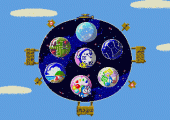
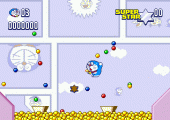
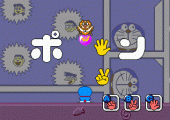
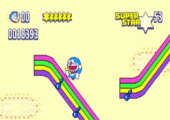
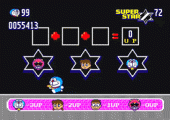
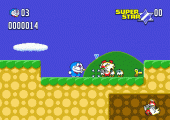
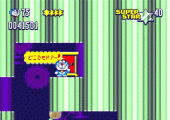
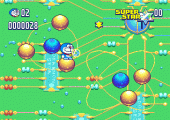
I really like that game. It reminded me more of Magical Tarurutokun, another import platformer, than of Mario but hey, I see the parallel. Only downside, the game is short and easy, I ended the game with something like 40 lives. Not so much variety either. But it sure is a fun ride, and the last boss is very original. 7/10 from me!